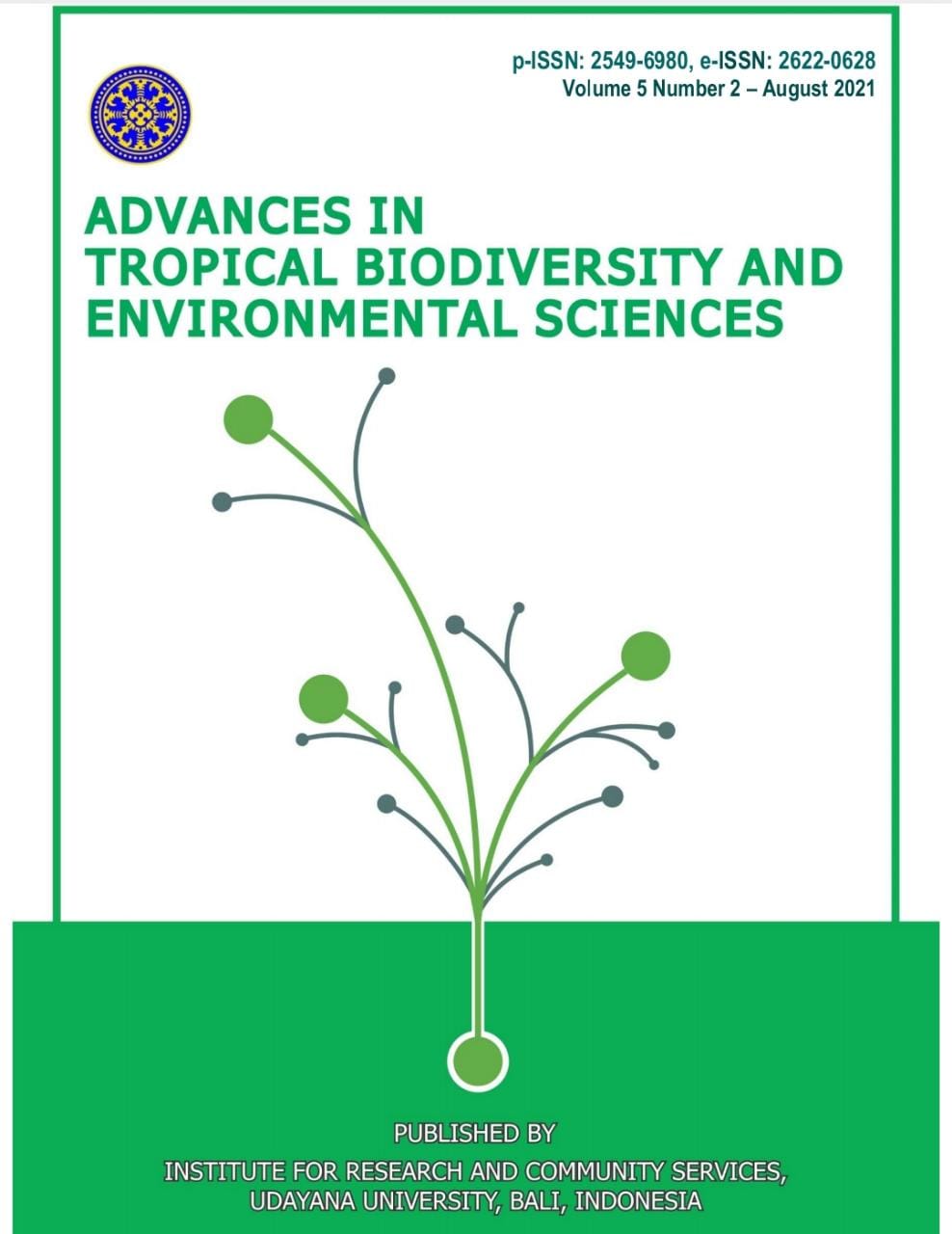Malassezia sp. Infection Prevalence in Dermatitis Dogs in Badung Area
Abstract
Malasseziosis is a common fungal infection in dogs and it is secondary to the initial underlying dermatitis infection. These infections can worsen the prognosis of disease in dogs. The study was conducted on 26 dogs that were treated in several veterinary clinics in the Badung, Bali. This study aimed to determine the incidence rate of Malassezia sp. in dogs with dermatitis. Samples were collected using tape smear method from the skin lesion and then by microscopic examination. The results were tabulated and analyze descriptively. The results showed that 15 of the 26 samples of dogs tested positive were infected with Malassezia sp. (58%). Infection is more common in male (60%) and geriatric dogs (40%). Lesions were more common in the ear, limb, vaginal and inguinal region of infected dogs
Downloads
References
[2] Wiryana, I. K. S., Damriyasa, I. M., Dharmawan, N. S., Arnawa, K. A. A., Dianiyanti, K., & Harumna, D. 2014. Kejadian dermatosis yang tinggi pada anjing jalanan di Bali. J. Vet, 15(2): 217-220.
[3] Widyastuti, S. K., & Utama, I. H. 2012. Kelaianan kulit anjing jalanan pada beberapa lokasi di Bali. Buletin Veteriner Udayana, 4 (2): 81-86.
[4] Seetha, U., Kumar, S., Pillai, R. M., Srinivas, M. V., Antony, P. X., & Mukhopadhyay, H. K. 2018. Malassezia Species Associated with Dermatitis in Dogs and Their Antifungal Susceptibility. Int. J. Curr. Microbiol. App. Sci, 7(6): 1994-2007.
[5] Guillot, J., & Bond, R. 2020. Malassezia yeasts in veterinary dermatology: an updated overview. Frontiers in cellular and infection microbiology, 10: 79.
[6] Concova. E., Sesztakova, E., Palenik, L., Smrco, P., Bilek, J. 2011. Prevalence of Malassezzia pachydermatis in Dogs with Suspected Malassezia Dermatitis or Otitis in Slovakia. Acta Vet.Brno, 80: 249-254.
[7] Midgley, G. 2000. The lipophilic yeasts: state of the art and prospects. Sabouraudia, 38 (Supplement_1): 9-16.
[8] Bajwa, J. 2017. Canine Malassezia dermatitis. The Canadian Veterinary Journal, 58(10): 1119.
[9] Coyner, K.S. (Ed.). 2019. Clinical Atlas of Canine and Feline Dermatology. John Wiley & Sons.
[10] Aspres, N., & Anderson, C. 2004. Malassezia yeasts in the pathogenesis of atopic dermatitis. Australasian journal of dermatology, 45(4): 199-207.
[11] Rostaher, A. 2016. Malassezia Dermatitis-How do I manage this? In: 8th World Congress of Veterinary Dermatology, Bordeaux, France, 31 May 2016 – 4 June 2016.
[12] Adiyati, P.N., & Pribadi, E.S. 2014. Malassezia spp. dan Peranannya sebagai Penyebab Dermatitis pada Hewan Peliharaan. Jurnal Veteriner 15 (4): 570-581.
[13] Patterson, A.P., & Frank, L.A. 2002. How to diagnose and treat Malassezia dermatitis in dogs. neoplasia, 1(2): 5.
[14] Morris, D.O., O’Shea, K., Shofer, F.S., & Rankin, S. 2005. Malassezia pachydermatis carriage in dog owners. Emerging infectious diseases, 11(1): 83.
[15] Borkar, R., Roy, K., Shukla, P.C., Gupta, D. 2014. Therapeutic Management of Malassezia Dermatitis in Dogs. Haryana Vet 53 (2): 106-109.
[16] Nardoni, S., Corozza, M., Mancianti, F. 2008. Doagnostic and Clinical Features of Animal Malasseziosis. Parasittol 4: 227-229.
[17] Bond, R., Patterson-Kane, J.C., & Lloyd, D. H. 2004. Clinical, histopathological and immunological effects of exposure of canine skin to Malassezia pachydermatis. Medical mycology, 42(2): 165-175.
[18] Nardoni, S., Dini, M., Taccini, F., & Mancianti, F. 2007. Distribusi dan ukuran populasi Malassezia pachydermatis pada kulit dan mukosa anjing atopik. Mikrobiologi veteriner , 122 (1-2): 172-177.
[19] Crespo, M. J., Abarca, M. L., & Cabañes, F. J. 2002. Occurrence of Malassezia spp. in the external ear canals of dogs and cats with and without otitis externa. Medical Mycology, 40(2): 115-121.
[20] Matousek, J. L., Campbell, K. L., Kakoma, I., Solter, P. F., & Schaeffer, D. J. 2003. Evaluation of the effect of pH on in vitro growth of Malassezia pachydermatis. Canadian journal of veterinary research, 67(1): 56.
[21] Sihelská, Z., Čonková, E., Váczi, P., & Harčárová, M. 2019. Antifungal Susceptibility of Malassezia pachydermatis Isolates from Dogs. Folia Veterinaria, 63(2): 15-20.
[22] Gaitanis, G., Magiatis, P., Hantschke, M., Bassukas, ID, and Velegraki, A. 2012. Genus Malassezia pada penyakit kulit dan sistemik. Ulasan mikrobiologi klinis, 25 (1): 106-141.
[23] Peano, A., Johnson, E., Chiavassa, E., Tizzani, P., Guillot, J., and Pasquetti, M. 2020. Resistensi Antijamur Mengenai Malassezia pachydermatis: Di Mana Kita Sekarang? Jurnal Fungi, 6 (2): 93.
[24] Miller WH, Griffin CE, Campbell KL. Muller & Kirk’s Small Animal Dermatology. 7th ed. St. Louis, Missouri: Elsevier, 2013:243–249.













